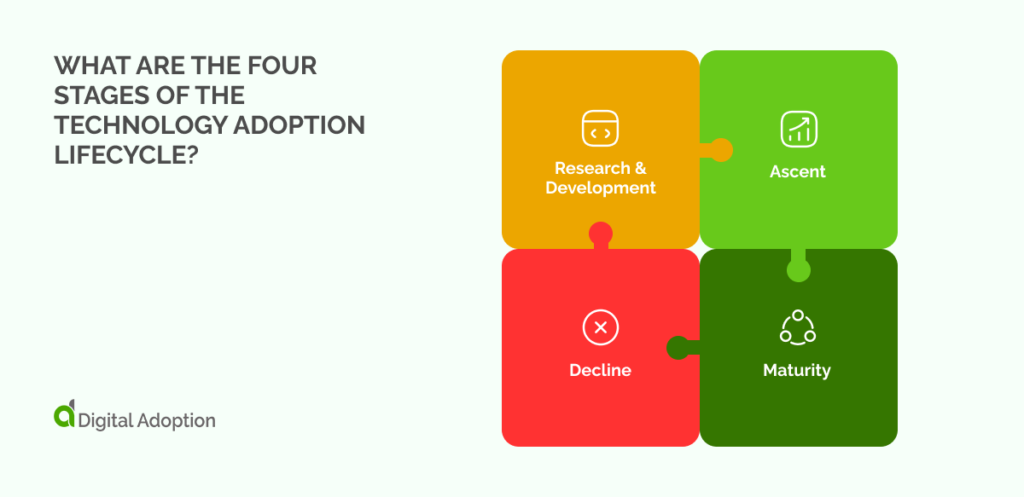The four stages of the technology adoption life cycle can be infinitely helpful in supporting team members at every level. But how can team members be categorized into groups? What does each group mean? And what can be done to help each team member based on their group and place on the adoption curve?
Looking closely at the technology adoption life cycle will help us answer these questions. Technology adoption can then be successfully implemented to the advantage of the company, increasing success in profits, output, and employee experience.
What Is The Technology Adoption Lifecycle?
Rogers developed the technology life cycle in 1962 based on the work of a soviet social scientist to understand how people use technology. Due to its usefulness, the life cycle is still used today by any company wanting to track the mass consumer market’s adoption of a new product.
The life cycle represents how different people, based on age, income, and other demographic and psychological characteristics, begin adopting a new piece of technology. In time, such new technology reaches its potential, diffusing among all society members until it becomes second nature.
There are five stages of new technology customer engagement, called the five adopter groups. These five adopter categories are Innovators, early adopters, early majority, late majority, and laggard.
- Innovators
The smallest group, innovators, are the youngest and the first to adopt new technology. Innovators are also the highest in the social class of all the groups and have the highest level of sociability toward others. In addition, innovators have the most heightened financial lucidity.
The other two major factors of the innovator’s group are that they are in close contact with scientific resources, giving them the edge in knowledge and understanding of new technologies. Crucially, innovators also have a high tolerance to risk, which means they are likely to purchase an item despite knowing it may not become successful.
- Youngest group
- The first group on the adoption curve
- Highest financial lucidity (understand the value of money)
- Crucially, high-risk tolerance.
- Early Adopters
Early Adopters are young but slightly older than innovators and more youthful than any remaining groups. Early adopters are the second on the adoption curve, making them the second to adopt new technologies.
Early adopters are the opinion leaders, meaning they inform the opinions of others around them the most out of all five groups. They are opinion leaders because they are the most sociable of all the groups and communicate their opinions and ideas more effectively, frequently, and to larger audiences.
Contrasted to innovators, early adopters have even higher social status and usually have a higher education level than all the groups. As a result of this education, early adopters are more careful and take time to research the best products for them. This careful consideration ensures their central communication position.
- Young but slightly older than innovators
- The second group on the adoption curve
- Early adopters are the opinion leaders
- Most social of all the groups
- Early Majority
The early majority group takes significantly longer to adopt an innovation than innovators and early adopters, but less than the remaining groups. The amount of time taken to adopt new technology is longer too.
The early majority group typically has above-average social status and has contact with early adopters. But because of their later adoption, early majority group members rarely fulfill an opinion leadership function.
- Adopt an innovation after a varying degree of time
- The time for adoption is significantly longer
- Above-average social status
- Late Majority
The late majority is not far behind the early majority, adopting new technology just after the average consumer. With this adoption, a high degree of skepticism remains about the potential of the new technology, even after the majority of society formed from the previous three groups has already adopted it.
Members of the late majority usually have below-average social status and very little financial lucidity. Late majority members discover new technologies through contact with the late majority and early majority, but not usually with innovators. As a result of this and low sociability, the late majority has a very low opinion of leadership.
- Adopt an innovation after the average member of the society
- Approach an innovation with a high degree of skepticism after the majority of society has adopted the innovation
- Below the average social status
- Laggards
The laggard group is the final group to adopt any new technological innovation. Laggards tend to be opposed to change agents and are usually the oldest group and most focused on traditions.
Laggards are likely to have the lowest social status and the lowest financial lucidity. As a result of being in contact only with family and close friends, laggards usually have little to no opinion on leadership.
- Last to adopt an innovation
- Usually older age group than other categories
- Lowest social status
Technology Adoption Lifecycle Example: Bitcoin

Cryptocurrencies such as Bitcoin are fascinating to view in the context of the technology adoption life cycle and the technology adoption curve. In the early days of Bitcoin, around 2008 onwards, users of social media sites such as Reddit (Innovators) adopted Bitcoin and began purchasing it in increasingly large amounts. At this time, it had a meager value, purchased at pennies or cents per Bitcoin.
Within a few years, more prominent social media influencers (Early Adopters) on YouTube and Twitter began to take note of Bitcoin and speak about it as a wise financial investment. Not long after this, working-age adults became more interested in Bitcoin (Early Majority), causing its value to skyrocket as it gathered strength. Some banks and online retailers also began acknowledging Bitcoin as an acceptable payment.
In 2020 Bitcoin became mainstream. Working-age consumers approaching retirement (Late Majority) with an interest in finance began buying and using Bitcoin. And finally, retired consumers of advanced age (Laggards) started to seek out an awareness of Bitcoin. Some from this group began investing in the future of their close friends or family members.
Bitcoin is a fascinating example of a product or currency within the technology life cycle because it will not be popular forever. Despite its current popularity, Gartner predicts that “by 2024, 20% of large enterprises will use digital currencies for payment, stored value or collateral, even though 84% of surveyed financial executives say it is a risk”.
Bitcoin is considered a financial risk due to its volatility, but the fact remains that it has brought cryptocurrency into the mainstream market. As a result, Stablecoin will likely replace Bitcoin as the dominant.
Because of this risk, but because Bitcoin has made cryptocurrencies mainstream, what will likely come in place of Bitcoin is Stablecoin. When Stablecoin becomes mainstream, it will have seen the exact structure of popularity as Bitcoin, being adopted by the different groups and then eventually falling out of use almost wholly.
This example shows how the life cycle of any technology, no matter how popular, is finite. Companies can learn a lot about their new products by tracking the progress of new technologies using the technology life cycle.
What Are The Four Stages Of The Technology Adoption Lifecycle?

The technology life cycle shows how long a product lasts in the mainstream market. Investment leads to the product becoming popular. Eventually, its popularity dies, and the substitution stage depends on whatever new technology replaces it. The technology life cycle is much longer for established products like cement manufacturing, as the building industry will always need cement.
The four stages of the technology adoption life cycle represent changes in a product life cycle based on how the public views and how much they buy, use and understand the product. These also fit with the bell curve of the technology life cycle and its categories. However, the life cycle is much shorter for technology products such as smartphones or tablets, as newer models replace products.
The technology adoption lifecycle is an s curve shape and contains two ways of describing each stage. The stages and phases of the technology life cycle go hand in hand, and the first of these four stages is research and development.
The four stages elaborate on the public view of a product and how this affects its popularity. The two ways of describing the stages exist because two social scientists, Soviet Kondratiev in 1925 and Rogers in 1962, contributed to developing and refining the technology life cycle.
- Research & Development
The first stage of any new product is research and development. New ideas are produced all the time by companies eager to create the next new technology for people to adopt quickly and from which companies can extract large profits. Innovative products must also be practical and easy to use. An important aspect is that the research accurately reflects user need based on current and predicted future behaviors informed by current trends used to discover potential users.
The point at which the Research and development stage occurs on the chart is part of the s curve, which falls below the line of profit. A company cannot make a profit; despite the investment, there is an initial loss. This stage is a hugely high-risk, high-cost time for a company, as it is unknown whether the investment will make a return. There are many innovation stages in this part of the process, where experimentation is encouraged. This stage is called the bleeding edge.
- Ascent
The stage where the product becomes known and creates interest with the public is the leading-edge stage or the ascent phase. Advertising budgets are high to let the public know the details of the product. This stage is also known as the syndication stage; a new effect is demonstrated and commercialized for use by the public with the hope of it becoming a market leader. Any new app can be an excellent example of this.
The first two adopter groups, innovators and early adopters, begin purchasing and using the product within the ascent phase. Users from these two groups begin to disseminate information about the products to those of the other three groups. The ascent phase is also when a company can recover investment costs.
- Maturity
The maturity stage, also known as the diffusion phase, is when the product reaches its zenith, hitting its peak and becoming as popular as it will ever become. Many consumers are discussing and purchasing the product. Diffusion refers to consumers communicating with each other to popularize the product as it diffuses throughout the mainstream market.
- Decline
The decline or substitution stage is when the product is used less and shifts fewer units. Profits go down, as does interest in the product. The substitution is the current product for a newer or alternative brand or model, which is the final stage in the technology life cycle. The recent app example applies here for apps with specific niche uses not used for very long.
What Is A Technology Adoption Curve?
It all begins with an innovation trigger, which comes from innovation theory. The technology adoption curve visually represents the path technology diffusion takes as a new product gains popularity. How this can look will change based on the product’s success or how long it takes to become popular.
Innovations trigger
The trigger is when a technological breakthrough sparks new technology use. At this point, the usable product does not exist and whether it is financially viable for the mainstream market is unknown. The media shares conceptual designs, which spark public interest.
Chasm
The chasm is a significant part of the graph, representing the space between innovators and early adopters. A product cannot become popular in the mainstream market as users in all five stages must use it to reach its full potential when this chasm is unfilled. Crossing the chasm is therefore crucial to success. Crossing the chasm has also been written extensively by influential business writer Geoffrey Moore who Gartner often cites.
The peak of inflated expectations
Early media engagement has several successes, but many failures often follow these. Some companies act on these failures, but a lot do not.
Trough of disillusionment
Interest goes down as experiments and attempts to prove the product’s worth do not deliver on promises. Those who created the new technology abandon it or fail. Investors only maintain confidence if the designing company can make the product reach the expectations of early adopters.
Slope of enlightenment
Examples of why and how the new technology has the potential to be an advantage to the enterprise company become clear and easily understood by media and consumers. Products of the second and third generations are released. More enterprises invest in future pilot schemes, yet some companies remain cautious of investment.
Plateau of productivity
Adoption by the mainstream market increases hugely. The new technology has much clearer viability, accessibility, and relevance within the market, showing visible returns on investment.
How Can Businesses Leverage The Technology Adoption Life Cycle?
The technology adoption life cycle has a broad array of business applications, and any business can utilize the life cycle to their advantage. The life cycle tracks the success of a product from the product development phase to the new technology becoming part of the status quo for everyone or most people in the mass consumer market as the product reaches market saturation.
Many entrepreneurs use the technology adoption life cycle to inform technology development based on data collected from customers at different stages for previous technologies. Crossing the chasm is a large part of meeting these aims.
Businesses can leverage the technology life cycle in one of two ways. The life cycle plots the diffusion of innovation stages of a new product for consumers. However, the life cycle plan the diffusion of the innovation stage of new technology for team members as part of a technology adoption strategy or a transformation strategy.
If used as part of a transformation or technology adoption strategy, the CEO
Companies can use the technology adoption lifecycle to become a market leader in a specific technology based on tracking the progress of rival companies’ technologies.
Secret elements are one of many factors that influence popularity. If a company can build a base of loyal customers, that can be hugely advantageous, as there is always a group fighting for the corner of the product, while there may be fierce critics. The harsh critics then become the product fans when its popularity peaks.
Many innovations do not reach their potential because companies do not acknowledge that the curve goes from left to right and that this process takes time.
Technology products have a typical life cycle, which companies must be mindful of when designing products and budgeting funding for research and development.
Making The Technology Life Cycle Work For You

Many examples exist of products and services presented in proof-of-concept in the media for an extended period, increased anticipation, and then for an extended period did not hit these expectations. Virtual Reality (VR) is one example of this. VR has come and gone for several decades, promising much and delivering little.
The late success of this technology may be due to many reasons related to the constraints of the technology itself. VR may have been seen as a niche item and not for many consumers’ benefit. However, non-technical factors influence a product within the new technology life cycle. For example, cost, public perception, or even fear of this new VR technology and how it might change society could have come into play.
The VR headset is now becoming increasingly popular. Perhaps this is due to the technology catching up with the device’s needs to feel immersive. It could also be the proliferation of geek culture and society’s acceptance and dependence on technology.
When looking at such examples, companies can also apply the technology life cycle principles to team members. The life cycle model can be used on a company population, especially in larger enterprises, to see where certain team members are on the technology adoption curve as part of a digital transformation strategy. Meetings and feedback exchanges are useful to discover why and remedy such obstacles if adoption is not as fast as expected as part of a change management plan.
There are many uses internally and externally for companies of many sizes for the technology life cycle. It is a diverse tool that can measure consumers’ and team members’ diffusion of new technology to increase profits and improve user experience.













